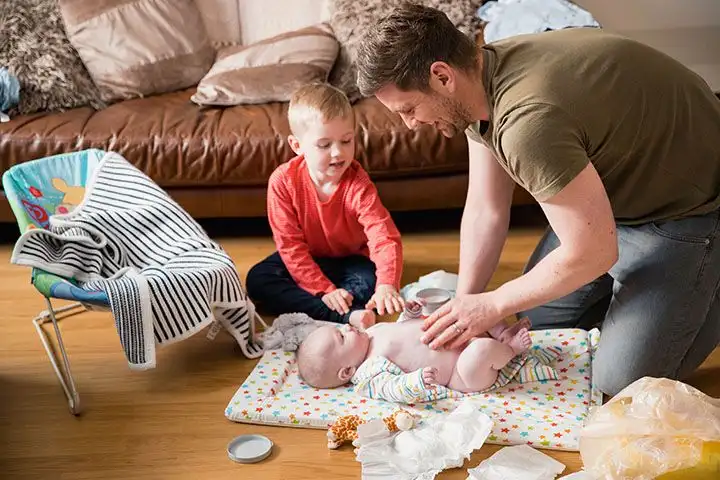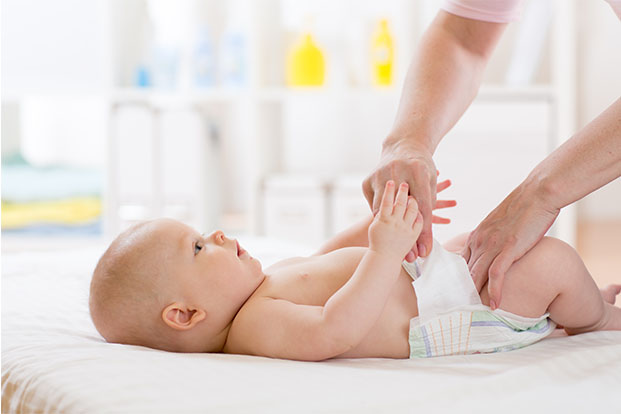Nappy Change Tips with Dettol
- Getting Organised
- Where and When to Change a Nappy
- Nappy Changing Procedure
- Nappy Hygiene
- How to Stop the Spread of Germs
- General Nappy Change Tips
Getting Organised
You will change a lot of nappies in your baby’s early years —about 10 to 12 each day for newborns and 5 to 8 each day for older babies — so it helps to have everything you need on hand for nappy changes:
- Clean nappies
- Cotton wool and warm water or nappy wipes
- Barrier cream
- Spare clothes
- Plastic bag or nappy sack for dirty nappies

There are two kinds of nappies, disposable and reusable, both of which have an impact on the environment. Other factors to consider when you are choosing the best nappies for you and your baby include cost, convenience, time, and performance. For example, disposable nappies are highly absorbent and easy and convenient to use, while reusable nappies can be more cost-effective but require time and effort to clean and dry.
Where and When to Change a Nappy
A changing mat is a good place to change your baby’s nappy. You can place the changing mat on the floor or a changing table. If you use a changing table, always keep your hand on your baby to prevent falls.
You should change your baby’s nappy every 3 to 4 hours, and as soon as possible after your baby does a poo. Changing your baby’s nappies frequently helps to prevent nappy rash. Newborn babies often poo during or after feeding, so it can sometimes be better to wait until after feeding to change your baby’s nappy.

Nappy Changing Procedure
Wash your hands with soap and water (or use hand sanitiser if handwash is not available) before you start a nappy change, then follow these steps:
- Lay your baby on their changing mat, remove their pants or other clothes as needed, and undo the dirty nappy
- You can use the front of the nappy to wipe off poo, then gently lift your baby’s bottom to remove the dirty nappy and place it out of baby’s reach
- Use damp cotton wool or baby wipes to gently clean your baby, always wiping from front to back, then apply a barrier cream
- Gently lift your baby’s bottom and slide a clean nappy underneath, then raise the front of the nappy up and fasten it around your baby’s waist before redressing your baby
- For newborn babies, remember to fold down the waist to keep the umbilical cord stump uncovered
Nappy Hygiene
Boys often wee during a nappy change, so try covering their penis to avoid getting sprayed! Gently clean around your baby boy’s genitals, then position the penis downwards before securing the nappy to prevent leaks at the waistline.
For girls, gently clean in all their creases. Always wipe from front to back to avoid spreading germs from their bottom.

How to Stop the Spread of Germs
Roll up and seal dirty disposable nappies using the tabs, then place them in a plastic bag or nappy sack before putting them in the outside rubbish bin. Reusable nappies should be washed separately to other clothing in hot water (at least 60°C) after removing any solid material.

Always wash your hands thoroughly before and after changing your baby’s nappy, as well as after disposing of the dirty nappy and cleaning the changing mat, to help prevent the spread of germs. Dettol Parents Approved^ Hand Washes not only kill 99.9% of germs, but are also free from harsh chemical residues, parabens and dyes.
When you’re on-the-go and access to soap and water isn’t available, Dettol Instant Hand Sanitiser is a convenient alternative, or you can also try Dettol 2 in 1 Hands & Surfaces Antibacterial Wipes. As the name suggests, they can be used to kill 99.9%* of germs on surfaces, which makes them very useful.
*For surfaces: E.coli, Staphylococcus
General Nappy Change Tips
Talking, singing, and being silly with your baby during change time can help baby relax, and it’s a great way to help the two of you bond as well as baby’s development!
Wearing a nappy all the time can irritate your baby’s delicate skin. Try these tips to help prevent nappy rash:
- Change your baby’s nappies frequently
- Use disposable nappies to quickly absorb moisture away from your baby’s skin
- Use cotton wool and warm water instead of baby nappy wipes, which can irritate some babies’ skin
- Give your baby some nappy-free time to air and dry out the skin
- Apply a barrier cream (for example, one that contains zinc oxide) at every nappy change to protect your baby’s skin; do not use talcum powder
Always read the label. Follow the directions for use.
^Dettol’s Parents Approved is becoming Free From! We’re renaming our range of hand washes and shower gels to make it easier for shoppers to find Dettol products that are free parabens, dyes and harsh chemical residues (no harsh residues as shown by dermatological testing), and that use 100% natural fragrances.
RB-M-13587.
First published:
Last updated:
